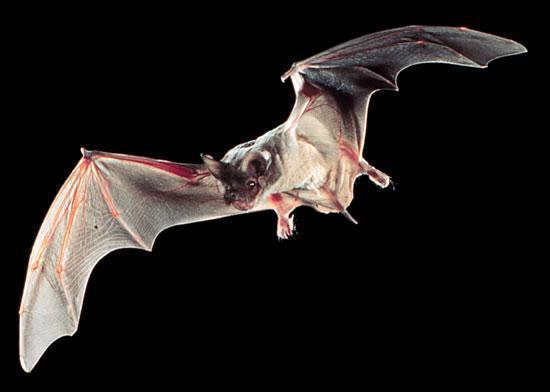


Tadarida brasiliensis in flight. Photograph by Ron Groves, U.S. Department of Transportation.
This is a medium-sized bat with broad ears, large feet, and the last half of its tail is free (extending beyond the membrane that extends between the legs). Its wide ears extend to the tip of its snout when laid forward and have a series of wart-like structures on the front rim. The tragus (an upward projection from the bottom of the ear opening) is small and blunt, and the feet have distinct white bristles on the inner and outer toes (Davis and Schmidly, 1994). The dorsal side appears dark brown or dark gray with white bases (Whitaker,1980). The adult bats average 102 mm in length and weigh about 12 g (Cockrum, 1982).
Tadarida brasiliensis uses caves, mine tunnels, hollow trees, old wells, bridges, and buildings as daytime hideouts. They are frequently called "house bats" because of their fondness for buildings (Davis and Schmidly, 1994).
This species is found throughout the southwestern United States and north to southern Oregon and Nebraska. Toward the eastern areas, the bat spreads north to northern Louisiana, Alabama, and South Carolina Whitaker, 1980).
The bat feeds on night-flyers, especially small moths. They are precise hunters that can bite off the soft abdomen of a moth in flight and let the wings, legs, and thorax fall to the ground (Cockrum, 1982).
Large maternity colonies are formed in the late spring where a single young is usually born in late June (Cockrum, 1982). More than 70% of the young are born within a brief 10-day span. These newborn young are left together, naked and unable to fly, on specific areas of the ceiling. Because of the incubator-like climate of many of their cave dwellings, the babies grow rapidly and, within a month after birth, most of the offspring are furred and capable of flying out for night feedings (Davis and Schmidly, 1994).

Tadarida brasiliensis maturnity roost. The dark gray mass is of roosting bats. The main body of bats is in the fissure cutting diagonally across the lower left. The view is toward the ceiling of the maturnity cave and is almost vertical. Hidalgo Co., NM, 17 May 1984. © Arthur H. Harris.
This bat draws considerable attention because of its renowned ability to carry rabies (it is second only to the eastern red bat). Probably one of the most spectacular things about this flying mammal is the enormity of individual numbers within the colonies. Carlsbad Caverns houses colonies numbering in the millions, and their emergence in the evening is said to be breathtaking. They fly in intricate and aggressive patterns, each one following the same general path of the one in front of it (Davis and Schmidly, 1994). The life span is 13-18 years and their only predators are hawks and owls (Whitaker, 1980).
Cockrum, E. L. 1982. Mammals of the Southwest. University of Arizona Press, Tucson, 176 pp.
Davis, W. B., and Schmidly, D. J. 1994. The Mammals of Texas. Texas Parks and Wildlife Press, Austin, 338 pp.
Whitaker, J. O., Jr. 1980. The Audubon Society Field Guide to North American Mammals. Alfred A. Knopf, Inc., 745 pp.
Todd Spurgeon, October 1997.
Last Update: 21 Jul 2009